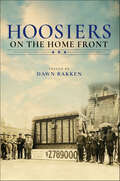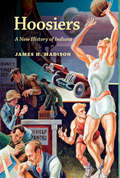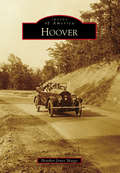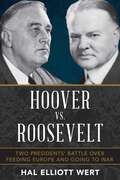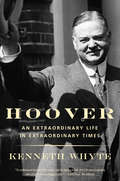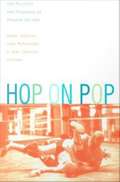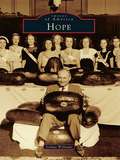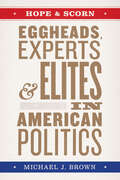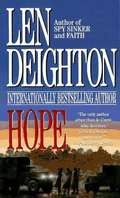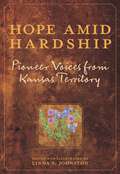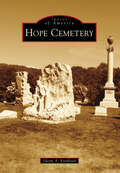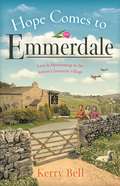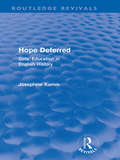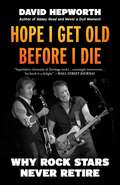- Table View
- List View
Hoosiers on the Home Front
by Dawn BakkenWars are fought on the home front as well as the battlefront. Spouses, family, friends, and communities are called upon to sacrifice and persevere in the face of a changed reality. Hoosiers on the Home Front explores the lives and experiences of ordinary Hoosiers from around Indiana who were left to fight at home during wartimes. Drawn from the rich holdings of the Indiana Magazine of History, a journal of state and midwestern history published since 1905, this collection includes original diaries, letters and memoirs, and research essays—all focused on Hoosiers on the home front of the Civil War through the Vietnam War. Readers will meet, among others, Joshua Jones of the 19th Indiana Volunteer Regiment and his wife, Celia; Attia Porter, a young resident of Corydon, Indiana, writing to her cousin about Morgan's Raid; Civil War and World War I veterans who came into conflict over the Indianapolis 500 and Memorial Day observances; Virginia Mayberry, a wife and mother on the World War II home front; and university students and professors—including antiwar activist Howard Zinn and conservative writer R. Emmett Tyrrell Jr.—clashing over the Vietnam War.Hoosiers on the Home Front offers a compelling glimpse of how war impacts everyone, even those who never saw the front line.
Hoosiers: A New History of Indiana
by James H. MadisonThe story of this Midwestern state and its people, past and present: &“An entertaining and fast read.&” ―Indianapolis Star Who are the people called Hoosiers? What are their stories? Two centuries ago, on the Indiana frontier, they were settlers who created a way of life they passed to later generations. They came to value individual freedom and distrusted government, even as they demanded that government remove Indians, sell them land, and bring democracy. Down to the present, Hoosiers have remained wary of government power and have taken care to guard their tax dollars and their personal independence. Yet the people of Indiana have always accommodated change, exchanging log cabins and spinning wheels for railroads, cities, and factories in the nineteenth century, automobiles, suburbs, and foreign investment in the twentieth. The present has brought new issues and challenges, as Indiana&’s citizens respond to a rapidly changing world. James H. Madison&’s sparkling new history tells the stories of these Hoosiers, offering an invigorating view of one of America&’s distinctive states and the long and fascinating journey of its people.
Hoover (Images of America)
by Heather Jones SkaggsThe community of Hoover began as a seed planted in the young mind of William Henry Hoover Sr. (1890-1979). Hoover's father dreamed of a city for working families, and the younger Hoover used this vision as a road map to build a strong municipality that grew with business, community, and family living. Through hard work and determination, Hoover opened Employers Mutual of Alabama's first office in Birmingham in 1922. He later founded the early town of Hoover in 1954 and in 1958 moved his company to the area that would be incorporated in 1967 as the city of Hoover. Several nearby communities are older than the city itself. Images of America: Hoover looks at Bluff Park, Shades Mountain, Rocky Ridge, Green Valley, and Patton (Patton's) Chapel as some of the early areas where Hoover's great story began.
Hoover vs. Roosevelt: Two Presidents' Battle over Feeding Europe and Going to War
by Hal Elliott WertHerbert Hoover, out of office since his defeat in 1932 by Franklin Roosevelt, maintained a strong international reputation due to his achievements as an engineer and his success during World War I and beyond in organizing aid for the starving millions of Europe. And yet, in nearly all accounts of the ferocious debate over American aid to Europe before the United States entered World War II, Hoover&’s role has been overlooked. Hoover vs. Roosevelt tells the story of American efforts to stay out of war following the German invasion of Poland. Historian Arthur Schlesinger, Jr., called it &“the most savage political debate of my lifetime.&” Both men fiercely disagreed on how to respond but the heart of their disagreement was over aid for the huge numbers of Polish refugees flooding into neighboring countries and those that were left behind. Hoover found Roosevelt&’s policy of limited emergency aid unacceptable, countering by rapidly assembling teams comprised of talented people who had served in prior Hoover relief organizations. Here for the first time are the courageous stories of those that achieved that success in Romania, Hungary, and Lithuania. When the Soviets invaded Finland on November 30, Hoover assisted the Finns by conducting a Hollywood, star-studded campaign spearheading nation-wide support for this small country. But Hoover&’s relief efforts were complicated by his burning ambition to obtain the Republican presidential nomination, a second opportunity to defeat Roosevelt. For Roosevelt, Hoover&’s relief successes threatened to derail his limited aid policy which aimed to conserve resources to assist Britain and France and could also cost the president votes. Politics aside, Hoover wars in the first year of the war succeeded in forcing Roosevelt to provide far more aid then intended. Hoover&’s victory, the only one achieved in his battles with Roosevelt, accomplished relief for hundreds of thousands in need.Widely and deeply researched in an array of rarely used secondary and primary sources, both domestic and international. Hoover vs. Roosevelt reveals the story of the two contenders&’ battles over feeding Europe and going to war.
Hoover, Blacks, and Lily-Whites: A Study of Southern Strategies (Unc Press Enduring Edition Ser.)
by Donald J. LisioFor more than fifty years, Hoover has been viewed as a lily-white racist who attempted to revitalize Republicanism in the South by driving blacks from positions of leadership at all party levels. Lisio demonstrates that this view is both inaccurate and incomplete, that Hoover hoped to promote racial progress. He shows that Hoover's efforts to reform the southern state parties led to controversy with lily-whites as well as blacks in both the North and the South.Originally published in 1985.A UNC Press Enduring Edition -- UNC Press Enduring Editions use the latest in digital technology to make available again books from our distinguished backlist that were previously out of print. These editions are published unaltered from the original, and are presented in affordable paperback formats, bringing readers both historical and cultural value.
Hoover: An Extraordinary Life in Extraordinary Times
by Kenneth WhyteThe definitive biography of Herbert Hoover, one of the most remarkable Americans of the twentieth century--a revisionist account that will forever change the way Americans understand the man, his presidency, and his battle against the Great Depression. A poor orphan who built a fortune, a great humanitarian, a president elected in a landslide and then routed in the next election, arguably the father of both New Deal liberalism and modern conservatism--Herbert Hoover is also one of our least understood presidents, conventionally seen only as a heartless failure for his handling of the Great Depression. Kenneth Whyte fully captures this rich, dramatic life: from Hoover's difficult childhood to his meteoric business career, his work saving hundreds of thousands of lives during World War I and after the 1927 Mississippi floods, his presidency, his painful defeat by Roosevelt, and his return to grace as Truman's emissary to help European refugees after World War II. Whyte brings to life Hoover's complexity and contradictions--his modesty and ambition, ruthlessness and extreme generosity--as well as his political legacy. Here is the epic, poignant story of the poor boy who became the most accomplished figure of his time, who worked ceaselessly to fight the Depression yet became the public face of America's greatest economic crisis. Here, for the first time, is the definitive biography that captures the full scale of this extraordinary life.
Hop on Pop: The Politics and Pleasures of Popular Culture
by Henry Jenkins Tara Mcpherson Jane ShattucHop on Pop showcases the work of a new generation of scholars--from fields such as media studies, literature, cinema, and cultural studies--whose writing has been informed by their ongoing involvement with popular culture and who draw insight from their lived experiences as critics, fans, and consumers. Proceeding from their deep political commitment to a new kind of populist grassroots politics, these writers challenge old modes of studying the everyday. As they rework traditional scholarly language, they search for new ways to write about our complex and compelling engagements with the politics and pleasures of popular culture and sketch a new and lively vocabulary for the field of cultural studies. The essays cover a wide and colorful array of subjects including pro wrestling, the computer games Myst and Doom, soap operas, baseball card collecting, the Tour de France, karaoke, lesbian desire in the Wizard of Oz, Internet fandom for the series Babylon 5, and the stress-management industry. Broader themes examined include the origins of popular culture, the aesthetics and politics of performance, and the social and cultural processes by which objects and practices are deemed tasteful or tasteless. The commitment that binds the contributors is to an emergent perspective in cultural studies, one that engages with popular culture as the culture that "sticks to the skin," that becomes so much a part of us that it becomes increasingly difficult to examine it from a distance. By refusing to deny or rationalize their own often contradictory identifications with popular culture, the contributors ensure that the volume as a whole reflects the immediacy and vibrancy of its objects of study. Hop on Pop will appeal to those engaged in the study of popular culture, American studies, cultural studies, cinema and visual studies, as well as to the general educated reader. Contributors. John Bloom, Gerry Bloustein, Aniko Bodroghkozy, Diane Brooks, Peter Chvany, Elana Crane, Alexander Doty, Rob Drew, Stephen Duncombe, Nick Evans, Eric Freedman, Joy Fuqua, Tony Grajeda, Katherine Green, John Hartley, Heather Hendershot, Henry Jenkins, Eithne Johnson, Louis Kaplan, Maria Koundoura, Sharon Mazer, Anna McCarthy, Tara McPherson, Angela Ndalianis, Edward O'Neill, Catherine Palmer, Roberta Pearson, Elayne Rapping, Eric Schaefer, Jane Shattuc, Greg Smith, Ellen Strain, Matthew Tinkhom, William Uricchio, Amy Villarego, Robyn Warhol, Charles Weigl, Alan Wexelblat, Pamela Robertson Wojcik, Nabeel Zuberi
Hope
by Joshua WilliamsLocated in the southwest corner of Arkansas, in one of the oldest counties of the state, the town of Hope has reflected the industrial vision of the New South since 1873 when the first lots were sold by the Cairo and Fulton Railroad Company. Hope has been home to nationally known politicians Bill Clinton and Mike Huckabee; acclaimed musicians like Patsy Montana; entrepreneur Paul Klipsch of Klipsch Speakers; and the farmer of the f44-year world-record watermelon, O. D. Middlebrooks. From thriving banks and local businesses to brickyards and handle factories, the people and places of Hope reflect the industrial nature and vision of a New South railroad town combined with the charm of small-town America.
Hope & New Orleans: A History of Crescent City Street Names (Landmarks)
by Sally AsherNew Orleans is a city of beautiful contradictions, evidenced by its street names. New Orleans crosses with Hope, Pleasure and Duels. Religious couples with Nuns, Market and Race. Music, Arts and Painters are parallel. New Orleans enfolds its denizens in the protection of saints, the artistry of Muses and the bravery of military leaders. The city's street names are inseparable from its diverse history. They serve as guideposts as well as a narrative that braid its pride, wit and seedier history into a complex web that to this day simultaneously joins and shows the cracks within the city. Learn about Bourbon's royal lineage, the magnitude of Napoleon's influence, how Tchoupitoulas's history is just as long and vexing as its spelling and why mispronouncing such streets as Burgundy, Calliope and Socrates doesn't mean you are incorrect--it just means you are local Told with precision and photos as vibrant, irreverent and memorable as La Nouvelle Orleans itself, author Sally Asher delivers an updated and reinvented look at the city that care forgot.
Hope & Scorn: Eggheads, Experts, & Elites in American Politics
by Michael J. BrownIntellectuals “have been both rallying points and railed against in American politics, vessels of hope and targets of scorn,” writes Michael J. Brown as he invigorates a recurrent debate in American life: Are intellectual public figures essential voices of knowledge and wisdom, or out-of-touch elites? Hope and Scorn investigates the role of high-profile experts and thinkers in American life and their ever-fluctuating relationship with the political and public spheres.From Eisenhower’s era to Obama’s, the intellectual’s role in modern democracy has been up for debate. What makes an intellectual, and who can claim that privileged title? What are intellectuals’ obligations to society, and how, if at all, are their contributions compatible with democracy? For some, intellectuals were models of civic engagement. For others, the rise of the intellectual signaled the fall of the citizen. Carrying us through six key moments in this debate, Brown expertly untangles the shifting anxieties and aspirations for democracy in America in the second half of the twentieth century and beyond. Hope and Scorn begins with “egghead” politicians like Adlai Stevenson; profiles scholars like Richard Hofstadter and scholars-turned-politicians like H. Stuart Hughes; and ends with the rise of public intellectuals such as bell hooks and Cornel West. In clear and unburdened prose, Brown explicates issues of power, authority, political backlash, and more. Hope and Scorn is an essential guide to American concerns about intellectuals, their myriad shortcomings, and their formidable abilities.
Hope (Bernard Samson #8)
by Len DeightonBernard Samson returns to Berlin in the second novel in the classic spy trilogy, FAITH, HOPE and CHARITY. Bernard is trying hard to readjust his life in the face of questions about his wife Fiona, and her defection to the East. Is she the brilliant high-flyer that her Department seems to think she is? Or is she a spent force, a wife and mother unwilling or unable to face her domestic responsibilities? Bernard doesn't know but is determined to find out. Bernard's boos Dicky Cruyer is certainly not anxious to reveal what he knows, as he jostles for power with Fiona herself in London Central, and takes to the road with Bernard on a mysterious mission to Poland.
Hope Against Hope: A Memoir
by Nadezhda MandelstamOf the eighty-one years of her life, Nadezhda Mandelstam spent nineteen as the wife of Russia's greatest poet in this century, Osip Mandelstam, and forty-two as his widow. The rest was childhood and youth." So writes Joseph Brodsky in his appreciation of Nadezhda Mandelstam that is reprinted here as an Introduction. Hope Against Hope was first published in English in 1970. It is Nadezhda Mandelstam's memoir of her life with Osip, who was first arrested in 1934 and died in Stalin's Great Purge of 1937-38. Hope Against Hope is a vital eyewitness account of Stalin's Soviet Union and one of the greatest testaments to the value of literature and imaginative freedom ever written. But it is also a profound inspiration--a love story that relates the daily struggle to keep both love and art alive in the most desperate circumstances. Nadezhda Mandelstam was born in Saratov in 1899. She met Osip Mandelstam in 1919. She is also the author of Hope Abandoned (1974). She died in 1980. Nadezhda means "hope" in Russian.
Hope Amid Hardship: Pioneer Voices from Kansas Territory
by Linda JohnstonWhy did they stay? Despite the challenges of loneliness, drought, and political turmoil Kansas pioneers faced, many found and wrote about joy and beauty in their adopted communities. Letters and diaries describe the times that gave them reason to sing, dance, and celebrate – moments when their burdens were lighter. This volume brings together reflections of 50 individuals of different ages, backgrounds, and outlooks who helped shape the identity of the Sunflower State.
Hope And Hard Work: The Early Settlers At Gustavus Alaska
by James R. MackovjakHistory of the early settlement of Gustavus Alaska.
Hope Cemetery (Images of America)
by Glenn A. KnoblockHope Cemetery in Barre, Vermont, is one of New England's most renowned graveyards. This 85-acre "open-air museum" is noted for the artistry and craftsmanship of its monuments, derived exclusively from legendary Barre gray granite. The cemetery attracts thousands of visitors every year, particularly when the foliage turns during fall. Barre was a boomtown with a rapidly rising population of European immigrants, especially those from Italy and Scotland, seeking opportunities as artisan carvers and laborers in the area's granite quarries. Ethnic enclaves developed around Barre; most notably, the city's north end became known as Little Italy. This diversity is captured in granite on the monuments of those interred at Hope Cemetery--not only in the surnames etched in stone but also in the monuments' widely varying symbols of remembrance. Within Hope Cemetery, memorials range from traditional European forms, including angels, cherubs, and other religious hallmarks, to highly individualized modern monuments depicting images representative of family life, interests, and leisure in the form of such diverse objects as lounge chairs, airplanes, race cars, a soccer ball, and many more.
Hope Comes to Emmerdale: a heartwarming and romantic wartime story (Emmerdale, Book 4)
by Kerry BellThe perfect Mother's Day gift full of nostalgia and warmth, for fans of ITV's Emmerdale and readers who love heartwrenching stories set during wartime.World War II wages on. Rationing, blackouts, evacuees and military training camps have become the norm in the village of Beckindale, but happiness has been found during these hard times. Lily Dingle is getting married, Annie Pearson has returned after volunteering with the Wrens, and there are new neighbours to get to know... including a female vet of all things. The new inhabitants are about to learn things are never dull for the families of Emmerdale.Exploring the lives of Emmerdale's much-loved families during World War II, including favourites such as the Sugdens and the Dingles, Hope Comes to Emmerdale is a hopeful and nostalgic novel about community, friendship and love.
Hope Comes to Emmerdale: a heartwarming and romantic wartime story (Emmerdale, Book 4) (Emmerdale)
by Kerry BellThe perfect Mother's Day gift full of nostalgia and warmth, for fans of ITV's Emmerdale and readers who love heartwrenching stories set during wartime.World War II wages on. Rationing, blackouts, evacuees and military training camps have become the norm in the village of Beckindale, but happiness has been found during these hard times. Lily Dingle is getting married, Annie Pearson has returned after volunteering with the Wrens, and there are new neighbours to get to know... including a female vet of all things. The new inhabitants are about to learn things are never dull for the families of Emmerdale.Exploring the lives of Emmerdale's much-loved families during World War II, including favourites such as the Sugdens and the Dingles, Hope Comes to Emmerdale is a hopeful and nostalgic novel about community, friendship and love.
Hope Deferred: Girls' Education in English History (Routledge Revivals)
by Josephine KammHope Deferred, initially published in 1965 traces the history of girls’ education from Anglo-Saxon England to modern times, telling the story largely through the leading personalities whose opinions and prejudices shaped this history. It outlines the progress of popular education and the work of the pioneers who fought to bring girls’ education at every level into line with boys’; and it carries the story into the second half of the twentieth-century to discuss the problem of whether girls are really receiving the right kind of education.
Hope Dies Last: Keeping the Faith In Troubled Times
by Studs TerkelAmerica&’s most inspirational voices, in their own words: &“If you&’re looking for a reason to act and dream again, you&’ll find it in the pages of this book&” (Chicago Tribune). Published when Studs Terkel was ninety-one years old, this astonishing oral history tackles one of the famed journalist&’s most elusive subjects: Hope. Where does it come from? What are its essential qualities? How do we sustain it in the darkest of times? An alternative, more personal chronicle of the &“American century,&” Hope Dies Last is a testament to the indefatigable spirit that Studs has always embodied, and an inheritance for those who, by taking a stand, are making concrete the dreams of today. A former death row inmate who served nearly twenty years for a crime he did not commit discusses his never-ending fight for justice. Tom Hayden, author of The Port Huron Statement, contemplates the legacy of 1960s student activism. Liberal economist John Kenneth Galbraith reflects on the enduring problem of corporate malfeasance. From a doctor who teaches his young students compassion to the retired brigadier general who flew the Enola Gay over Hiroshima, these interviews tell us much about the power of the American dream and the force of individuals who advocate for a better world. With grace and warmth, Terkel&’s subjects express their secret hopes and dreams. Taken together, this collection of interviews tells an inspiring story of optimism and persistence, told in voices that resonate with the eloquence of conviction. &“The value of Hope Dies Last lies not in what it teaches readers about its narrow subject, but in the fascinating stories it reveals, and the insight it allows into the vast range of human experience.&” —The A.V. Club &“Very Terkelesque—by now the man requires an adjective of his own.&” —Margaret Atwood, The New York Times Review of Books &“An American treasure.&” —Cornel West
Hope Endures
by Nigel TranterThe son of an Edinburgh merchant, Hope had a spectacular beginning to his career: at the age of seventeen, before he had even finished his legal education, he travelled to France to triumph in his first court case and caught the attention of his young king, James VI. It was the beginning of a life at the heart of the government of Scotland. From James VI and I to Cromwell, from John Knox to Montrose, Lord Advocate Hope was a rock in a fast-changing world. He witnessed the reigns of Charles I and Charles II, the founding of the East India Company, affairs of state and affairs of the heart, matters political and diplomatic. No dry-as-dust-lawyer, he was a friend as well as an advisor to the three kings he served. An age of change, violence and upheaval brought vividly to life in this gripping historical novel. HOPE ENDURES is the last novel Nigel Tranter completed before his death in January 2000.
Hope Endures
by Nigel TranterThe son of an Edinburgh merchant, Hope had a spectacular beginning to his career: at the age of seventeen, before he had even finished his legal education, he travelled to France to triumph in his first court case and caught the attention of his young king, James VI. It was the beginning of a life at the heart of the government of Scotland. From James VI and I to Cromwell, from John Knox to Montrose, Lord Advocate Hope was a rock in a fast-changing world. He witnessed the reigns of Charles I and Charles II, the founding of the East India Company, affairs of state and affairs of the heart, matters political and diplomatic. No dry-as-dust-lawyer, he was a friend as well as an advisor to the three kings he served. An age of change, violence and upheaval brought vividly to life in this gripping historical novel. HOPE ENDURES is the last novel Nigel Tranter completed before his death in January 2000.
Hope I Get Old Before I Die: Why Rock Stars Never Retire
by David HepworthFrom the author of Abbey Road and Never a Dull Moment, the basis for AppleTV's 1971 documentary, come the stories of how rock icons like Pink Floyd, Bruce Springsteen, Mick Jagger, and more have survived, thrived, and remained the most powerful forces in music.When Paul McCartney closed Live Aid in July of 1985, we thought he was rock&’s Grand Old Man. He was forty-three years old. As the forty years since have shown, he—and many others of his generation—were just getting started. This was the time when live performance took over from records. The big names of the &’60s and &’70s exploited the Age of Spectacle that Live Aid had ushered in to enjoy the longest lap of honor in the history of humanity, continuing to go strong long after everyone else in the business had retired. This is a story without precedent, a story in which Elton John plays a royal funeral, Mick Jagger gets a knighthood, Bob Dylan picks up a Nobel Prize, The Beatles become, if anything, bigger than The Beatles, and it&’s beginning to look as though all of the above will, thanks in a large part to technology, be playing in Las Vegas forever.
Hope Springs Eternal: French Bondholders and the Repudiation of Russian Sovereign Debt
by Anthony Bulger Kim OosterlinckIn 1918, the Soviet revolutionary government repudiated the Tsarist regime's sovereign debt, triggering one of the biggest sovereign defaults ever. Yet the price of Russian bonds remained high for years. Combing French archival records, Kim Oosterlinck shows that, far from irrational, investors had legitimate reasons to hope for repayment. Soviet debt recognition, a change in government, a bailout by the French government, or French banks, or a seceding country would have guaranteed at least a partial reimbursement. As Greece and other European countries raise the possibility of sovereign default, Oosterlinck's superbly researched study is more urgent than ever.
Hope Under Fire: Hope Stapleford Adventure 4
by Caroline DunfordSet in London during the Blitz, Hope Under Fire is the fourth exciting spy thriller in Caroline Dunford's World War II Hope Stapleford Adventures.It is late August 1940 and British Intelligence agent Hope Stapleford is desperate to join the Special Operations Executive. But spymaster Fitzroy, now Hope's stepfather, has promised to protect her, so instead he sends her to work in the home propaganda department of the Ministry of Information.When bombs start to fall in London and lives are tragically lost, Hope secretly becomes an ARP warden and her asset, Harvey, becomes a nightshift fireman on the East End docks. And as the Blitz rages on, Hope must keep the nation's spirits up, while never knowing where the next threat to her safety lies . . .Readers LOVE Caroline Dunford's gripping Second World War thrillers!'Wonderful in its writing, characterisation and plot the book never fails to entertain' ⭐ ⭐ ⭐ ⭐ ⭐'This is one of the best written mystery series that I have read' ⭐ ⭐ ⭐ ⭐ ⭐'They're so well written that they're hard to put down! I can't wait for the next one!' ⭐ ⭐ ⭐ ⭐ ⭐'This has got to be one of the best writers of mystery books' ⭐ ⭐ ⭐ ⭐ ⭐
Hope Under Fire: Hope Stapleford Adventure 4
by Caroline DunfordSet in London during the Blitz, Hope Under Fire is the fourth exciting spy thriller in Caroline Dunford's World War II Hope Stapleford Adventures.It is late August 1940 and British Intelligence agent Hope Stapleford is desperate to join the Special Operations Executive. But spymaster Fitzroy, now Hope's stepfather, has promised to protect her, so instead he sends her to work in the home propaganda department of the Ministry of Information.When bombs start to fall in London and lives are tragically lost, Hope secretly becomes an ARP warden and her asset, Harvey, becomes a nightshift fireman on the East End docks. And as the Blitz rages on, Hope must keep the nation's spirits up, while never knowing where the next threat to her safety lies . . .Readers LOVE Caroline Dunford's gripping Second World War thrillers!'Wonderful in its writing, characterisation and plot the book never fails to entertain' ⭐ ⭐ ⭐ ⭐ ⭐'This is one of the best written mystery series that I have read' ⭐ ⭐ ⭐ ⭐ ⭐'They're so well written that they're hard to put down! I can't wait for the next one!' ⭐ ⭐ ⭐ ⭐ ⭐'This has got to be one of the best writers of mystery books' ⭐ ⭐ ⭐ ⭐ ⭐
